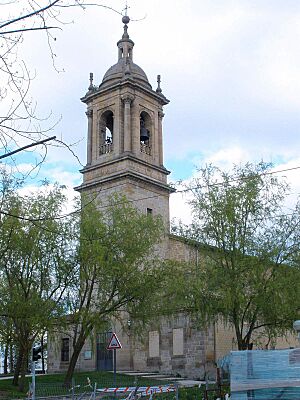Arriaga-Lakua facts for kids
Arriaga-Lakua was once a small village in Álava, part of the Basque Country in Spain. Today, it is a busy neighborhood within the city of Vitoria-Gasteiz.
Contents
Where is Arriaga-Lakua?
This neighborhood is located exactly where the old village used to be. It's about 2.5 kilometers (1.5 miles) from the center of Vitoria-Gasteiz. Arriaga-Lakua sits next to the Zadorra river. Only the neighborhood of Abetxuko is further north than Arriaga-Lakua.
A Look Back in Time
The first time Arriaga-Lakua was written about was in a document from the year 1025. This old record is found in the cartulary of San Millán de la Cogolla.
The village was important because it was very close to a place called "Campo de Lakua," which means "Field of Lakua." This is where important groups that ruled the people of Álava used to meet. A special group called the "Brotherhood of Arriaga" brought together the nobles of Álava to govern the area.
Arriaga-Lakua was one of the oldest villages near Vitoria-Gasteiz. It became part of the main city quite early on. In 1258, a special agreement called the Voluntaria Entrega happened. This meant the Brotherhood of Arriaga gave up their power over the Lordship of Álava to Alfonso XI, who was the king of Castilla. In return, they got to keep some of their special rights. Eight villages, including Arriaga and the city of Vitoria-Gasteiz, were given to the king. Even after this, Arriaga-Lakua continued to host the "Juntas Generales de Álava," which were like big general meetings.
During the Napoleonic Wars, a big battle called the "Battle of Vitoria" took place in Arriaga. Armies fought hard to control the bridge over the Zadorra river.
By the early 1960s, Arriaga-Lakua was still a small town with about 300 people, right at the edge of Vitoria-Gasteiz. But then, the city started to grow a lot. Vitoria-Gasteiz began to expand and surround the village. During the 1960s and 1970s, many new buildings were built, and the village officially became a neighborhood of Vitoria-Gasteiz.
Arriaga-Lakua Today
Not much of the original old town is left today. The most important parts that remain are the old parish church and the Hermitage of San Juan de Arriaga.
Arriaga-Lakua is managed by the Basque Government. It is divided into several smaller parts:
- Lakua 1
- Lakua 2
- Lakuabizkarra
- Lakua 12
- Lakua 13 or Lakua-Arriaga
More than 27,000 people live in Arriaga-Lakua, making it the biggest neighborhood in the city.
You can find cultural centers for people from Galicia, Asturias, and Andalusia behind "Gernikako Arbola" street. There is also a Christian center for Jehovah's Witnesses.
Famous People
Raúl Fuentes Cuenca, a singer, became a finalist representing Spain in Eurovision 2000.
Events
The neighborhood has its own yearly festival. It also hosts a special market that celebrates the Napoleonic era.
See also




